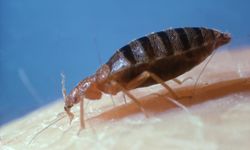 “Enjoy your new found independence…without bugs! Want to learn more? Check out these pictures of insects.Yellow Dog Productions/Lifesize/Getty Images
“Enjoy your new found independence…without bugs! Want to learn more? Check out these pictures of insects.Yellow Dog Productions/Lifesize/Getty Images
So you’re moving into a dorm room. Congratulations. Perhaps this is your first taste of freedom.
But, part of living on a college campus means that you’ll never be alone. You’ll have to deal with messy, loud hall mates and lots of other new neighbors. Dorm life can be an overwhelming situation, so it’s important to make your room as much of a sanctuary as possible — it’s one of the only places you can really retreat. It’s worth the investment in time (and just a little bit of money) to keep it clean, safe and free of intruders.
That said, there’s not much you can do to keep your roommate at bay…so we’re going to focus on the truly undesirable: The winged, the creepy crawlies, the beady eyed and the blood suckers. It’s easier to prevent an infestation than it is to cope with one that’s already underway, so it’s far better you know up front what you might be dealing with. Right?
Contents
- You Might be Late to the Party
- Keep the Windows Closed
- Keep Food Locked Up
- Don't Let Your Laundry Languish
- Choose Your Bedfellows Carefully
5: You Might be Late to the Party
 “A bed bug can easily survive a summer without human prey.Oxford Scientific/Getty Images
“A bed bug can easily survive a summer without human prey.Oxford Scientific/Getty Images
Your new dorm room might be freshly vacuumed; the door is probably decorated with a nametag that your RA stayed up all night to make. Sure, it looks welcoming. But that doesn’t mean it’s pristine, or even clean. And it definitely doesn’t mean your new home sweet home is all yours.
The best time to wage war on an intrusion is before it even starts. As soon as you arrive in your new room, you should look carefully for any signs of a bug or rodent infestation. You’ll be able to see everything without any obstructions, and if there are any problems, they can be taken care of before bugs get a chance to nest in your stuff.
Damage to a window or screen can give refuge to any number of insects, while mice might have enjoyed the opportunity to frolic around campus undetected. So closely check windowsills, lighting fixtures, closets, baseboards and even the edges of carpeting — while some creatures are obvious, others might be more difficult to see.
Now is also the best time to look for bedbugs. These disgusting little creeps can actually survive without feeding (shudder!) for several months, so contrary to popular belief, they can easily survive a summer without human prey. Look carefully around the seams of your mattress and in any cracks in your bed frame. If you see them, it’ll be a lot easier to kill them before you unpack your bedding and make the bed. (Also check the perimeter of the room along the floorboards, and any other soft or upholstered furniture.)
All clear? Then it’s time to open your suitcase and give your teddy bear some fresh air.
4: Keep the Windows Closed
It’s tempting to discount the importance of this one; after all, an open window lets you air out the room, gaze across the lawns, blare some music and generally enjoy the sense of community that a college campus is designed to encourage.
But it’s fairly obvious that it’s also an easy way to let outdoors creatures slip in. No matter how many floors up you live, winged nuisances can (and will) find their way in. Granted, a stray fly or mosquito is pretty harmless, but you might be surprised by the creatures that can find their way inside. Ladybugs, for example, are a notorious dorm room pest (especially the intrusive Asian species, characterized by their orange, rather than red, wings). Laugh if you will, but in the last five years or so, college students across the country have reported being plagued by swarms of ladybugs that can overtake a room, seemingly overnight. And ladybugs are resistant to pesticides, too — the only way to get rid of them is to suck them up with a vacuum until no further evidence of their presence remains.
Even if you can’t resist the urge to open the windows on a sunny afternoon, try to limit the amount of time you leave them unattended. Get in the habit of closing them at night, or when you know you’ll be in class most of the day.
If your dorm windows aren’t equipped with screens, see if you can install them; if they’re damaged, ask campus maintenance to repair or replace them. As an alternative, an inexpensive window fan can facilitate airflow without leaving everything wide open.
Or, you can just go outside.
3: Keep Food Locked Up
It’s unofficial dorm room protocol to hide the better parts of your personal food stash. Even a courteous roommate can have freeloader friends. But no matter how well you hide your snacks from people, they might not be safe from pests.
Mice (and rats, too!) can chew through cardboard and cellophane. If they’re really desperate for their next meal, they can even nibble through slightly thicker plastic, such as those inexpensive reusable food storage containers. Keep as much food as possible in your dorm fridge; everything else should be stored in sturdy, heavy plastic containers. Decorative metal tins are even better.
It’s generally advisable to avoid charming, homey touches like candy dishes and fruit bowls. Fresh flowers, unfortunately, are prone to the same misfortune. Their presence is like inviting ants and mosquitoes to a picnic. It’s hard to advise against something as cheerful as a bouquet of carnations, so perhaps a bit of lenience is in order. Check flower vases and potted plants frequently for signs of insects, and toss it when it starts to wilt.
College students should be experienced enough to know this, but we’ve seen otherwise, so here goes: Food trash should be thrown out immediately so it doesn’t attract flies. (Plus, formerly-edible garbage gives a small room a telltale funk that’s hard to erase).
If you keep your consumables under control, pests will get the message that you’re not willing to share.
2: Don't Let Your Laundry Languish
 “Do your laundry regularly — you don’t want your undershirts to turn into a den for bugs, do you?Jeffrey Coolidge/Riser/Getty Images
“Do your laundry regularly — you don’t want your undershirts to turn into a den for bugs, do you?Jeffrey Coolidge/Riser/Getty Images
Bugs like damp, dark places…especially silverfish, which are definitely things you don’t want creeping around in your clothing. (They’re flat, have antennae and a bunch of legs, and crawl fast. Like, unnaturally fast. They’ll disappear deeper into your laundry pile before you’re even sure of what you’ve seen.) But if you toss your dirties into a corner whenever you change your clothes, you’re basically asking for it.
Fortunately, there’s an easy fix for this one. Do your laundry regularly. As often as you can. It’s time consuming and, at dorm prices, it’s certainly not cheap. But it beats turning your undershirts into a den for bugs.
And in between loads, keep your dirty laundry off the ground. Even if you’re dropping your socks to the floor as you crawl bleary-eyed into bed, take a few seconds the next morning to put them in the hamper. Don’t step over them and leave them there; bend over, pick them up and put them where they belong. You might not want to touch them, but bugs are much less picky. And, while you’re at it, get a hamper that sits a few inches above the ground, preferably on a metal frame.
Dirty towels are the worst offender. Even if you use your towels a few times before washing them (that’s okay, you’re certainly not the only one) at least take the step of hanging your towel on a hook or over the back of your chair to let it dry. Don’t wad it up in a corner of the room, throw it on the windowsill, or kick it under the bed. You’re just inviting nasty things to go nest in it. (Silverfish love wet towels. Again… gross.)
And if you’re letting your towel sit around in what are probably the dirtiest parts of your room, you really shouldn’t be using it again anyway. Just sayin.’
1: Choose Your Bedfellows Carefully
In the battle for insect notoriety, bedbugs might just be the new cockroaches. Both have been around forever, but bedbugs have been seen as more of a threat in recent years. At least, in terms of breadth (how far and fast they’ve spread), depth (literally, how deeply they can infiltrate your home and your stuff) and longevity (it’s really hard to stop a bedbug infestation once it starts). And also, less scientifically, in terms of grossness. Though roaches have also been known to suck human blood, it isn’t their sole reason for existing, which we can assume only because they’ve been observed doing other things, like scurrying around.
So, bedbugs. They’re enjoying a resurgence and are becoming increasingly resistant to traditional methods of eradication. Once an infestation occurs, the only ways to kill them are heat (washing every single thing you own in extremely hot water) and chemical extermination. They’re especially threatening in a college dorm because they like densely populated areas. Contrary to popular belief, even a clean room can easily become infested in a multi-unit dwelling, since they easily and quickly move undetected from one area to another. (That’s what scientific types call condos and apartment buildings, and for our purposes, it also applies to dorms. It also explains why hotels are prone to bedbug problems.) Bedbugs can travel nearly undetected along carpeted hallways or through hollows in drywall, and experts believe they often enter dorms by hiding in students’ luggage during travel. That means even if you have good hygiene habits and keep your room clean, you’re still at risk.
Bedbugs prefer to burrow in mattresses because they’re dark and dense, and offer lots of seams, nooks and hidey-holes. Also, the proximity to a sleeping and unsuspecting human is not coincidental. Once a bedbug gets in a mattress, people usually believe the mattress is basically toast and beyond trying to save. It can be treated, but the process is expensive, doesn’t always work, and there’s no way to ensure it was successful, since bedbugs can burrow really deep where the chemicals and heat might not penetrate. There’s finally an alternative, though: the bedbug-proof mattress cover. Don’t balk at the price tag — it’s around 50 bucks or so. Just buy less expensive sheets if you have to make up a budget shortfall. This investment is much cheaper than the money, time and headache that would be caused by an infestation.
A high-quality bedbug mattress cover is made of a dense material that prevents the critters from burrowing or biting through, and it has special zippers that are designed to prevent anything from fitting through the grooves. It also prevents any bedbugs that have already nested in the mattress from finding their way back out (which is reassuring, yes, but also gross — but no worries, mattress cover manufacturers promise they’ll die within a year and a half). Any eggs that are already laid inside the mattress can’t escape after hatching, either. So, though a bedbug-proof mattress cover won’t kill bedbugs or prevent them from coming into your room at all, it’ll discourage them from hanging out. And if you’re lucky enough to have a box spring, go ahead and put one around that, too.
There might be bedbugs living in your school-issued mattress, waiting to die…but at least they won’t be able to bite you.
Lots More Information
Author’s Note: 5 Ways to Keep Pests Out of Your Dorm Room
Here’s an approach I do not recommend — the old "college try" (by which I mean, doing nothing at all).
I had a pair of friends who roomed together all through college. Our sophomore year, they chose a gigantic double room in a building that was a hundred years old (the first building to be completed on our campus). It could be said that the building was kind of decrepit. These girls weren’t exactly fastidious, either. So, one night, during a Super Smash Bros. session, I tried to ignore the quick, brown streak that appeared across the back wall, moving from one bed, behind the television, to the other bed.
"I think there’s a mouse in here," I said.
"Nah," said the occupants of the room. The other guests appeared unconcerned.
A few minutes later, the rodent in question cautiously approached a two-day-old pizza box which was holding a few calcified slices. Vindicated!
One of my friends casually rose from her spot, gathered her bags of chips and crackers from the floor underneath her bed, and dumped them in a Tupperware tub. The pizza stayed on the floor, the Nintendo game continued, all eyes fixed straight ahead and the mouse remained in their room for most of the year. On the upside, there were remarkably few flies and ladybugs.
Related Articles
- 10 Things Your Kid’s Dorm Room Doesn’t Need
- 5 Tips for Making Your Dorm Room a Home Away From Home
- Can steel wool stop mice?
- The Ultimate Bedbugs and Other Creatures in Your Room Quiz
- Top 5 Ways to Repel Insects
Sources
- Colonial Pest Control Inc. "Bed Bugs In Dorms." Sept. 13, 2011. (June 24, 2012) http://www.colonialpest.com/blog/bed-bugs-in-dorms
- Eden Advanced Pest Technologies. "Dorm Room Pest Control and Prevention." Sept. 14, 2011. (June 27, 2012) http://www.edenpest.com/blog/post/bed-bug-pest-control-pests-to-look-for-in-dorm-room
- Konkle, Stephanie. "Ole Miss, Oxford cope with ladybug invasion." The Daily Mississippian. Dec. 3, 2009. (June 24, 2012) http://thedmonline.com/article/ole-miss-oxford-cope-ladybug-invasion
- UMass Housing Department. "It is a ladybug and stinkbug season!" (June 29, 2012) http://www.housing.umass.edu/pdf/Ladybugs%20in%20your%20room.pdf
- Warner, Jennifer. "Foggers No Match For Bedbugs." WebMD. June 3, 2012. (June 24, 2012) http://www.webmd.com/skin-problems-and-treatments/news/20120603/foggers-no-match-for-bedbugs

































